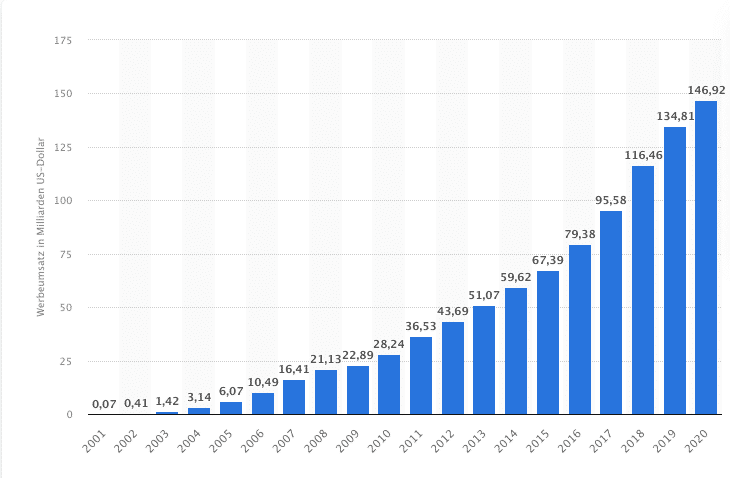Google Ads celebrated its 20th anniversary last year. Time to take a look at the success story of the advertising system, a direct comparison with Amazon Advertising and to examine the strengths and weaknesses of the two providers.
Exciting facts and figures about Google Ads
What is now Google Ads was known as Google AdWords until 2018. The service was launched two years after Google was founded in 2000 and has since enabled advertisements to be placed in the search advertising network and the display advertising network. With the help of keywords, advertisers can determine when their ads appear in Google's search results or are displayed on thematically relevant websites.
Billing is based either on the cost-per-click model (CPC) or on view contacts (CPM). With the former, the advertiser pays as soon as a user clicks on the ad. With the latter model, the advertiser only pays for the display of the ad, regardless of whether it is clicked on or not. The CPC model is more success-oriented and therefore more popular. The average cost per click is highest in the insurance industry at 3.04 $, closely followed by online education (2.13 $), automotive retail (1.46 $), online banking (1.42 $) and marketing and advertising (1.12 $). The lowest cost per click is paid by jewelry providers (0.57 $), companies in the cryptocurrency sector (0.5 $) and tour operators (0.44 $).
This is a lucrative business. In 2020, Google generated total revenue of 182.53 billion US dollars and is the most used search engine in the world with a market share of just under 80% (desktop) and 90% (mobile). The internet giant's advertising revenue is rising steadily and exceeded the 100 billion mark for the first time in 2018. In 2020, Google generated revenue of 146.92 billion US dollars.

The difference between the Advertising segments is large. As mentioned above, advertisers can advertise on the search engine itself (Search) or in the Google network on thematically matching websites (Display Network) place their ads. Since 2010, customers have also been able to book their ads directly on YouTube. In Germany, estimated revenue in the search segment amounted to USD 3,250 million, followed by YouTube at USD 550 million and the Display Network at USD 460 million.
Amazon becomes a competitor to Google
Google is also an important source of traffic for Amazon. In 2013, Amazon 158 million US dollars spent on search ads on Google. However, in recent years, the "customer Amazon" has increasingly become the "competitor Amazon". More and more people are starting their product searches on sales platforms such as Amazon instead of search engines such as Google. In order to be closer to their customers, advertisers are shifting their budgets. On Amazon, they are closer to the time of purchase with their ads and therefore have higher sales opportunities.
The two internet giants are competing for the advertising business. In 2018, Amazon migrated its Amazon Marketing Services (AMS), Amazon Advertising Platform (AAP) and Amazon Media Group (AMG) to a joint brand called Amazon Advertising. Google undertook a similar rebranding in the same year, turning Google AdWords into today's Google Ads was.
Amazon sales with digital advertising were USD 0.94 billion in 2015 and increased steadily to USD 1.44 billion in 2018. In 2020, Amazon achieved a US market share of just under USD 10% in the digital advertising business and generated sales of 21.5 billion US dollars have been recorded. This makes the advertising business one of Amazon's fastest-growing divisions and gives Google a run for its money in the ads business.
What advantages does Amazon Advertising for online retailers to reach new customers versus Google?
Amazon Advertising offers three different advertising solutions. "Sponsored Products" are ads for individual product listings on Amazon. They are displayed on the search results pages and product detail pages. "Sponsored Brands" present an entire brand including product portfolio. With a brand logo, a user-defined headline and a selection of products, these ads are displayed on the search results pages. "Sponsored Display" is a new self-service advertising solution that allows advertisers to reach relevant audiences throughout the customer journey with ad placements on and off Amazon.
More and more customers are starting their product search directly on Amazon instead of Google. The change in customer behavior is prompting companies to adjust their advertising budget.
Valued 50% of advertising expenditure for consumer goods have shifted from Google to Amazon. This is hardly surprising, as target groups are easier to persuade to complete a purchase with the help of Amazon ads. Anyone who buys on Amazon already has their credit card on file and is just one click away from making a purchase. Almost a third of Amazon Prime users need less than 3 minutes to make a purchase decision. Half of users purchase a product in under 15 minutes. 80% of Amazon Prime customers start their online shopping directly on Amazon, not Google.
In addition to transaction proximity, Amazon Advertising scores with further advantages. Like Google, Amazon Advertising leaves cost control to the retailer. The cost-per-click model gives advertisers the choice of how much they want to spend on their ads. Amazon Advertising also has an indirect effect on the organic results. If additional search traffic is purchased via Amazon Advertising and flows to the product detail pages, more product sales are achieved. These sales are included in the product's performance figures and thus improve the organic ranking. Paid conversions therefore increase the ranking of every retailer.
Small and large companies can create new incentives to buy on Amazon by displaying paid advertisements. About 300 million registered user profiles make it possible to address specific target groups. Amazon's wide reach also offers niche retailers access to the right customers.
A variety of campaign types make it easier to address customers. Automatic campaigns are ideal for getting started with Amazon Advertising. One campaign, one ad group and one offer for all search queries are sufficient. Amazon controls the ads automatically and there is no need to create a keyword list. If you want more control, you can use manual campaigns. Keywords and bids can be individually defined and coordinated. Targeting can be refined according to brand, rating and price. Keywords allow advertisers to directly influence where the ads are displayed. Google Shopping only offers a restriction through negative keywords, but otherwise decides alone where ads are shown. Also exciting: Amazon allows ads to be displayed on product detail pages of competitors and for complementary products, as I reported in this blog article point out.
What advantages does Google Ads for online retailers to reach new customers versus Amazon Advertising?
At the beginning, we shared many insights into Google Ads and looked at the history of the world's most successful SEA platform. Even though Amazon Advertising will become an even bigger competitor to Google Ads in the future, there are a few advantages to the advertising platform. The Top-of-Funnel Traffic, that can be achieved via Google should not be underestimated. For many users, the customer journey continues to begin via the search engine giant, shifting the focus from purely transactional searches to the early stages of the purchasing process. Many interested parties can be reached via Google Ads by asking questions and seeking help. When it comes to solving a problem, internet users start their search on Google.
Without perhaps already having a specific product in mind, the path via Google Ads leads to the online store with the right product that offers the solution to the problem being searched for. The traffic can also be directed straight to your own website or store, whereas it is not possible to link directly to Amazon. Google also scores with the largest video platform in the world and ads on YouTube offer enormous potential for traffic and sales on your own company website. Traffic that leads to the company's own pages is also an excellent source for collecting user data, which can be used for your own newsletter, for example.
Google Ads gives advertisers greater scope for designing their ads. Campaigns can be placed in the search, display or shopping network, and video campaigns and discovery campaigns can also be selected. Shopping campaigns are particularly relevant for the e-commerce sector. A distinction is made here between product and showcase shopping as well as ads with local inventory. Google Ads therefore offers a more diverse selection of campaigns than Amazon Advertising.
Another plus point are the Remarketing for Dynamic Search Ads (RSDA) - the are currently only available on Google and not on Amazon. Dynamic Search Ads make it possible to cover many search queries that might not have made it into the keyword set. No keywords need to be entered here; Google dynamically adapts the delivery of the ads to your own website. Internet users who have previously visited the website are "reminded" of the offers by the ads. RSDA is particularly useful for online stores and the e-commerce sector. With a high number and variety of products, many additional search queries can be covered that result from the product titles and associated product descriptions.
Conclusion: Who wins in the e-commerce ads business?
Amazon Advertising is much faster-moving and offers search marketers many different types of advertising. On Amazon, customers are already in the middle of the buying process, while searchers on Google are still very high up in the sales funnel. The general search volume on Amazon has already reached higher than with Google.
In contrast, Google Ads enables customer proximity in the long-tail area and in the upper sales funnel. Non-transactional searches can be better answered with Google Ads. If you want to advertise your own website, there is no getting around Google Ads. YouTube also offers exciting opportunities as an awareness and branding channel.
It is worth taking advantage of the opportunities offered by Amazon Advertising and at the same time not doing without Google Ads. Both advertising systems complement each other perfectly to reach customers at all stages of the purchasing process - but Amazon is significantly faster.
Note: Do you need support with campaign design & optimization on Amazon? Then we can help you as Amazon PPC Agency can help.

